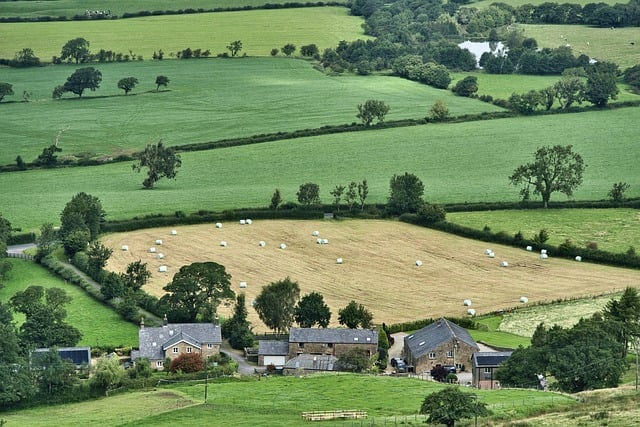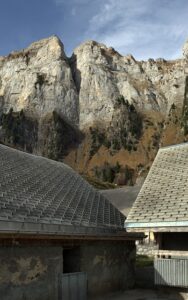Optimizing Central Tablelands Farm Sheds: Design, Evolution, and Efficiency for Modern Agriculture
2023 marked a significant transformation in agricultural efficiency within New South Wales' Central Tablelands, driven by the strategic deployment of advanced farm sheds. These structures have evolved beyond mere storage, becoming multifunc…….

2023 marked a significant transformation in agricultural efficiency within New South Wales' Central Tablelands, driven by the strategic deployment of advanced farm sheds. These structures have evolved beyond mere storage, becoming multifunctional hubs that optimize land and resource use, streamline workflow, and reduce operational costs. Key features include smart design with natural lighting and energy-efficient ventilation, durable materials like galvanized steel and recycled plastics, and the integration of modern technologies such as automated feeding systems and climate control for sensitive produce. Innovative practices such as the use of solar panels and wind turbines promote sustainability and cost savings. The Thompson family's and Davidson farm's success stories highlight how these sheds support diversification, improved livestock management, and value-adding activities, leading to reduced waste, better market timing, and increased profitability for local farms in the region. Farm Sheds have become a cornerstone of sustainable success, reflecting the commitment to innovation and efficiency in the Central Tablelands' agricultural sector.
explore the pivotal role of farm sheds in enhancing agricultural productivity within the Central Tablelands. This article delves into the tailored design requirements for these structures, tracing their evolution through materials and technologies. We’ll uncover strategies for maximizing efficiency via smart layouts and innovative features, with a focus on sustainability and cost-effectiveness. By examining case studies of successful farm shed implementations, insights are gleaned to inform best practices for Central Tablelands farms, ensuring these vital spaces serve as robust assets for the farming community.
- Assessing the Needs of Central Tablelands Farms for Optimal Farm Shed Design
- The Evolution of Agricultural Sheds in the Central Tablelands: Materials and Technologies
- Maximizing Efficiency with Smart Layouts and Innovative Features in Farm Sheds
- Case Studies: Success Stories of Farm Shed Implementation on Central Tablelands Farms
Assessing the Needs of Central Tablelands Farms for Optimal Farm Shed Design

Central Tablelands farms face unique challenges that necessitate carefully tailored farm shed designs to optimize functionality and efficiency. The variable climate, with its range from drought to flooding rains, demands sheds that can protect crops and equipment while accommodating seasonal variations. Farmers in this region must consider the durability of materials that can withstand harsh environmental conditions, ensuring that the farm sheds not only serve their purpose but also endure over time.
When assessing the needs for optimal farm shed design in the Central Tablelands, it’s crucial to evaluate factors such as the types of crops grown, livestock housed, and the scale of farming operations. Sheds must be designed with ample space for machinery, storage for feed and fertilizers, and areas dedicated to processing or packaging agricultural products. Additionally, incorporating design elements like natural lighting, efficient ventilation, and strategic placement can significantly enhance productivity and sustainability. By understanding these specific requirements, farm shed designs can be crafted to meet the precise needs of Central Tablelands farms, ensuring that they remain effective, adaptable, and resilient in the face of the region’s agricultural demands.
The Evolution of Agricultural Sheds in the Central Tablelands: Materials and Technologies

Over the years, farm sheds in the Central Tablelands have undergone significant transformations, both in materials and technologies utilized in their construction. Traditionally, these structures were built with readily available local materials such as timber from surrounding forests, corrugated iron for roofing, and simple joinery techniques. As the region’s agricultural practices evolved, so did the farm sheds. The introduction of more durable and versatile materials like galvanized steel, concrete, and recycled plastics has enhanced the structural integrity and longevity of these sheds. Concurrently, advancements in engineering have led to the development of sheds designed to withstand the unique climatic challenges of the Central Tablelands, including strong winds, heavy rains, and variable temperatures. These improvements have been complemented by the integration of energy-efficient design elements and smart storage solutions within farm sheds, ensuring they serve as optimal environments for a variety of agricultural activities. The evolution of farm sheds in the Central Tablelands reflects a commitment to innovation and sustainability, directly impacting the efficiency and profitability of local farms. Today’s farm sheds are not just shelters but are integral components of modern farming operations, leveraging technology to meet the demands of intensive agricultural production in the region.
Maximizing Efficiency with Smart Layouts and Innovative Features in Farm Sheds

In the Central Tablelands of New South Wales, where agriculture is both a livelihood and a legacy, the integration of smart layouts and innovative features in farm sheds plays a pivotal role in maximizing efficiency. These structures are not merely storage spaces but multifunctional hubs designed to cater to the diverse needs of modern farming operations. Strategic placement of sheds within farms ensures optimal use of land and resources, facilitating smooth workflow and minimizing the time spent on transportation and handling of agricultural produce and machinery. The incorporation of features such as natural lighting, energy-efficient ventilation systems, and modular designs allows for flexibility in storage solutions and adaptability to changing farm requirements. Moreover, the use of durable materials and advanced construction techniques not only contributes to the longevity of these sheds but also reduces maintenance costs over time. By investing in smartly designed farm sheds, Central Tablelands farmers can significantly enhance productivity and profitability, while also safeguarding against environmental challenges and seasonal fluctuations characteristic of the region.
The adoption of innovative technologies within farm sheds further amplifies their efficiency. Automated systems for feeding livestock, climate-controlled environments for sensitive produce, and integrated wash stations are just a few examples of how these structures can be tailored to specific farming needs. The integration of smart technology enables real-time monitoring and management of stock and resources, allowing for swift decision-making and improved response times to critical situations. Additionally, the implementation of solar panels and wind turbines within these sheds promotes sustainable practices, reducing carbon footprint and long-term operational costs. As a result, farm sheds in the Central Tablelands are not just evolving with the times but are becoming central to the sustainability and success of the region’s agricultural sector.
Case Studies: Success Stories of Farm Shed Implementation on Central Tablelands Farms

In the Central Tablelands of New South Wales, Australia, farm sheds have emerged as versatile and indispensable structures that enhance agricultural productivity and efficiency. A notable case study is that of the Thompson family, who adopted a series of well-designed farm sheds to diversify their operations. These sheds facilitated the storage of machinery, hay, and feed, ensuring that livestock were well cared for throughout the year, regardless of weather conditions. The Thompsons also utilized these structures for value-adding activities such as processing and packing, which not only streamlined their processes but also reduced spoilage and waste.
Another success story comes from the Davidson farm, where innovative farm shed implementation led to significant improvements in crop storage and handling. By investing in high-quality sheds with controlled environment features, the Davidsons were able to extend the shelf life of their produce, reducing loss and optimizing the timing of market release. This strategic use of farm sheds allowed them to capitalize on higher prices at optimal times, directly impacting their bottom line. These case studies highlight the transformative potential of farm sheds in the Central Tablelands, underscoring their role as more than mere storage solutions but as integral components of modern, efficient farming practices.






